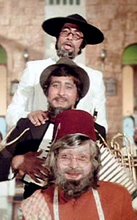Greetings non-existent friend and reader
Amar is an ignorant enthusiast of urdu poetry, and he also has a passion for old hindi cinema that for reasons that shall remain mysterious he has not seen (nor intends to). He is constantly thus stumbling upon mysteries which he cannot resolve (and which in fact may not be mysteries at all), and thus he turns to you, wiser and more knowledgable in these matters, for kindly assistance, and benevolent guidance. There are many such mysteries, it is hard to say how many will be tabled here eventually, but let us for the moment make a beginning.
Mystery Number One
Film: Taj Mahal
Year: 1963
Lyricist: Sahir Ludhianvi
Song: Jurm-e-Ulfat pe hamein log saza dete hain
Line: "Takht kya cheez hai, aur laal-o-jawahar kya hai, ishq wale to khudaee bhi luta dete hain"
In the year 1963, Jawahar Lal ("laal-o-jawahar") sits on the "takht" of India. Surely in some obtuse way the line is a reference to Nehru.
It cannot be a coincidence to talk of thrones, and then find it necessary to mention "red jewels" (is this translation even correct?). Why jawahar, why lal jawahar in particular? Is there a historical cultural non-Nehru association that explains why the talk of takht brings up lal-o-jawahar? If so, what?
And if it is a reference to Nehru, then what is it that Sahir wishes to say to us, besides showing his mastery of word play (a rich tradition of Desh incidentally, going back to the classical sanskrit poets)? Is it a criticism? What does Sahir want to say? That those in love are capable of losing even more than Nehru managed (1962 war?)?
There is Amar's mystery number one. Wise reader, enlighten Amar, and earn his everlasting gratitude.
ps: Amar doesn't translate the couplet, frankly, because he doesn't dare to. To those who are left stranded, apologies, but he fears the sacrilege of murdering poetry by dire translation.
skip to main |
skip to sidebar

Wait wait wait! You see the whole country of the system is juxtapositioned by the haemoglobin in the atmosphere because you are a sophisticated rhetorician intoxicated by the exuberance of your own verbosity!

Topics
- detection (6)
- dismalia (31)
- eating (16)
- epics (11)
- fantasies (57)
- fantasy (2)
- forecasts (8)
- games (2)
- history (61)
- humour (51)
- life (17)
- listening (24)
- musings (67)
- photo (190)
- poets (35)
- politics (88)
- racial profiling (2)
- reading (50)
- religion (17)
- romance (24)
- science (4)
- sports (27)
- surfing (1)
- the taxes of evil (1)
- travels (54)
- watching (33)
Blog Archive
We loved reading:
- Midnight's Children
- Alice in Wonderland
- A Play of Giants
- Bhagavad Gita
- Chander Pahar
- Cracking India
- Declaration of Independence
- Flashman series
- Guns, Germs and Steel
- His Dark Materials trilogy
- Kim
- Liberty or Death
- My Name is Red
- Our Dumb Century
- Shame
- The Book of the Book
- The Complete Nigerian
- The Crow Eaters
- The League of Extraordinary Gentlemen
- The Mandala of Sherlock Holmes
- The Mathnawi of Jalaluddin Rumi
- The Prophet
- The Proteus Operation
- The Pyrates
- The Quran
- The Rise of Islam and the Bengal Frontier, 1204-1760
- The Rubaiyat of Omar Khayyam
- The Satanic Verses
- The Sign of Four
- Tryst with Destiny
- When You Hear Hoof Beats Think of a Zebra
We loved watching:
- Analyze This and That
- Belleville Rendez-vous
- Black
- Casablanca
- Company
- Der Untergang (Downfall)
- Dil Chahta Hai
- Dr Strangelove or: How I Learned to Stop Worrying and Love the Bomb
- Fight Club
- International Gorilley [never seen]
- Kill Bill 1 and 2
- Kiss Kiss Bang Bang
- Life is Beautiful
- Lock, Stock and Two Smoking Barrels
- Nayak
- Qurbani
- Raiders of the Lost Ark
- Rang de Basanti
- Shichinin no Samurai (The Seven Samurai)
- Sholay
- Sin City
- Sonar Kella
- Star Wars series
- The Dollar Trilogy
- The Godfather Trilogy
- The Life of Brian
- The Maltese Falcon
- Wo Hu Cang Long (Crouching Tiger Hidden Dragon)
- Wong Fei Hung (Once Upon a Time in China) series